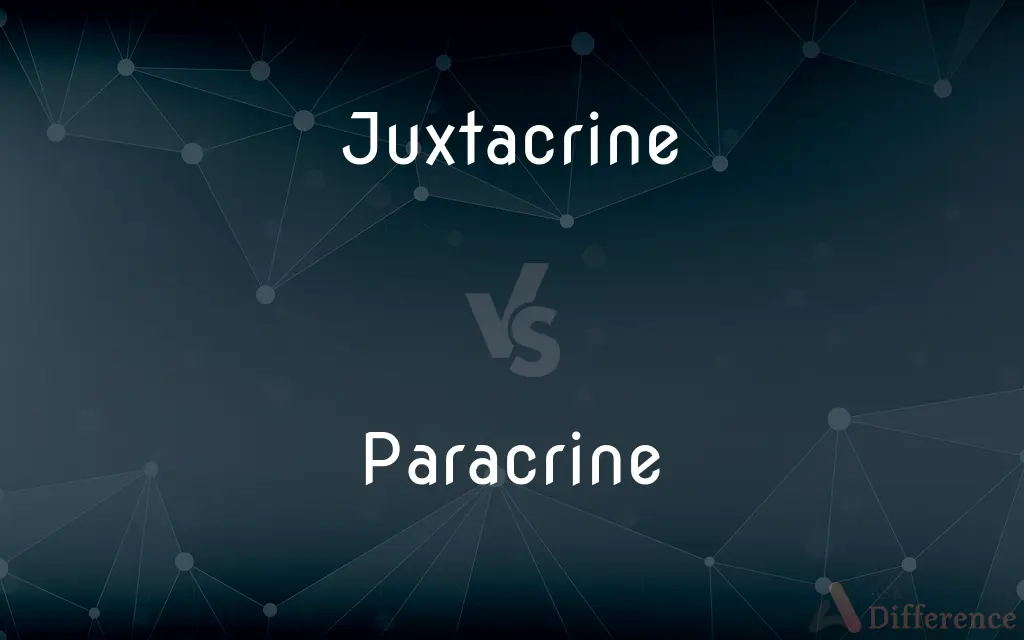Juxtacrine vs. Paracrine — What's the Difference?
By Urooj Arif & Maham Liaqat — Updated on March 20, 2024
Juxtacrine signaling involves direct cell-to-cell contact to transmit signals, while paracrine signaling uses extracellular fluid for communication between nearby cells.

Difference Between Juxtacrine and Paracrine
Table of Contents
ADVERTISEMENT
Key Differences
Juxtacrine signaling requires physical contact between cells, relying on molecules present on the cell surface for signal transmission. This direct contact ensures that signals are passed to specific target cells. On the other hand, paracrine signaling involves the release of signaling molecules into the extracellular fluid, allowing for the diffusion of these signals to nearby cells. This method is less specific than juxtacrine signaling, targeting a broader range of cells in the immediate vicinity.
In juxtacrine communication, the signal is often transmitted through cell adhesion molecules or gap junctions, which connect the cytoplasm of two cells, allowing for various molecules and ions to pass directly between cells. Whereas in paracrine signaling, the signals are usually small, soluble molecules such as growth factors, cytokines, or neurotransmitters that can easily diffuse through the extracellular space.
Juxtacrine signaling is crucial for processes that require precise communication, such as embryonic development and immune responses, where cells must interact closely and specifically. Paracrine signaling, on the other hand, is vital for broader communication tasks, like tissue repair or the regulation of local blood flow, where the signal needs to reach a larger number of cells.
One characteristic feature of juxtacrine signaling is its ability to mediate not only short-range communication but also long-range effects by initiating signaling cascades that can affect distant cells. Paracrine signaling, while primarily involved in local cell communication, can sometimes influence cells at a distance if the signaling molecules are not quickly broken down or if they are transported through circulation.
The specificity of juxtacrine signaling is also highlighted by its role in synaptic signaling within the nervous system, where neurotransmitters are released and bind to receptors on adjacent neurons. This is in contrast to paracrine signaling, where the release of neurotransmitters like dopamine can affect not just a single target cell but multiple cells within the vicinity of its release.
ADVERTISEMENT
Comparison Chart
Contact Requirement
Requires direct cell-to-cell contact
Does not require direct contact; operates through extracellular fluid
Signaling Molecules
Cell surface molecules
Soluble factors (e.g., growth factors, cytokines)
Specificity
High, due to direct contact
Lower, affects nearby cells broadly
Communication Range
Short-range; limited to cells in direct contact
Short to moderate range; depends on the diffusion of signaling molecules
Typical Functions
Embryonic development, immune responses
Tissue repair, regulation of local blood flow
Compare with Definitions
Juxtacrine
Utilizes cell surface proteins for signal transmission.
Notch signaling, a type of juxtacrine communication, controls cell fate decisions.
Paracrine
Can influence a broad range of cells in the vicinity.
Cytokine release during an inflammatory response is a form of paracrine signaling.
Juxtacrine
Mediates interaction through gap junctions for cytoplasmic exchange.
Cardiac cells use juxtacrine signaling to synchronize heartbeats.
Paracrine
Involves the release of signaling molecules that affect nearby cells.
Paracrine signaling in the pancreas regulates insulin secretion.
Juxtacrine
Involves direct communication between neighboring cells via physical contact.
During embryonic development, juxtacrine signaling dictates cell differentiation.
Paracrine
Utilizes soluble factors to mediate communication.
Growth factors promoting tissue repair are examples of paracrine signals.
Juxtacrine
Facilitates synaptic signaling in the nervous system.
Neurons communicate through juxtacrine signaling at the synaptic junction.
Paracrine
Dependent on the diffusion of molecules through extracellular fluid.
Neurotransmitter diffusion in the brain is an example of paracrine communication.
Juxtacrine
Essential for precise signaling in immune responses.
T cells rely on juxtacrine signals to activate upon encountering antigen-presenting cells.
Paracrine
Plays a crucial role in tissue repair and local blood flow regulation.
Paracrine signals from endothelial cells control vascular tone.
Juxtacrine
In direct contact (of one cell with another)
Paracrine
Of or relating to the release of locally acting substances from endocrine cells.
Common Curiosities
What is juxtacrine signaling?
It's a form of cell communication that requires direct physical contact between cells.
How does juxtacrine signaling contribute to the nervous system?
It mediates synaptic signaling, essential for neuron-to-neuron communication.
Can juxtacrine signaling affect distant cells?
Yes, through initiated signaling cascades that can propagate effects.
Why is juxtacrine signaling important?
It ensures precise communication for processes like development and immune response.
How does paracrine signaling differ from juxtacrine signaling?
It does not require direct cell-to-cell contact and has broader target cell specificity.
How does juxtacrine signaling transmit signals?
Through cell surface molecules that interact upon contact.
Can paracrine signals reach distant cells?
Typically, they affect nearby cells, but certain conditions can extend their influence.
What types of molecules are involved in paracrine signaling?
Small, soluble molecules like growth factors and cytokines.
What is paracrine signaling?
A communication method where cells release signaling molecules into the extracellular fluid to affect nearby cells.
What role does paracrine signaling play in the body?
It's crucial for tissue repair, immune responses, and regulating local physiological processes.
Share Your Discovery

Previous Comparison
Marine vs. Navy
Next Comparison
Subway vs. UndergroundAuthor Spotlight
Written by
Urooj ArifUrooj is a skilled content writer at Ask Difference, known for her exceptional ability to simplify complex topics into engaging and informative content. With a passion for research and a flair for clear, concise writing, she consistently delivers articles that resonate with our diverse audience.
Co-written by
Maham Liaqat














































